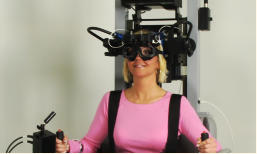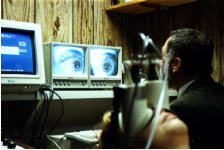Balance Laboratory Investigations (some of the methods we use to identify how severe is the balance problem and what balance systems are causing the symptoms.)
Test of Balance Capacity:
Computer Analysis of :

Dynamic Posturography: Includes changes in stability with head movement at velocities of everyday life.
(Physiologic Velocity): Ability to maintain stability when what you stand on(support surface) or what you see moves.

Dynamic Visual Acuity: Ability to see clearly when your head moves at physiologic velocities
Postural Evoked Response: Timing of muscle response to sudden shifts in support surface
Tests of specific balance system sensors:
Computer analysis of :
Stimulation of each semicircular canal: (anterior, posterior, lateral) at speeds that occur in everyday life (physiologic velocities) (Physiologic Heat Thrust)
See Video
Utricular function:
Centrifuge: stimulation of each side’s utricle with measurement of visual vertical and eye torsion.
Ocular Vestibular Evoked Myogenic Potential: sound stimulus of each side’s utricle with measurement of eye muscle response.
Saccular Function:
Cervical Vestibular Evoked Myogenic Potential: sound stimulus of each side’s saccule with measurement of neck muscle response.
Central(Brain) Function:
Rotary Chair: Evaluation of phase of vestibular ocular reflex (VOR)and of time constant.

VOR with fixation and with enhancement
Response of slow and fast phase of eye movement to optokinetic stimulus
Presence of Optokinetic After Nystagmus
Video Nystagmography:

Evaluation of cervical nystagmus
Transtympanic electrocochleography
Evaluation of Volume status of endolymph and indirectly integrity of closure of inner ear fluids.
